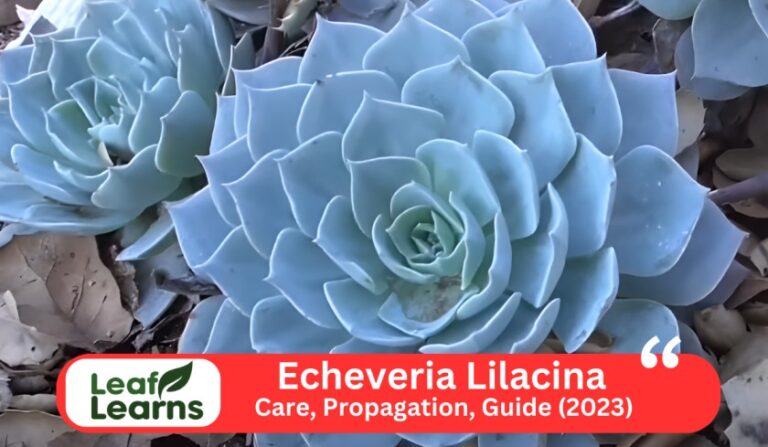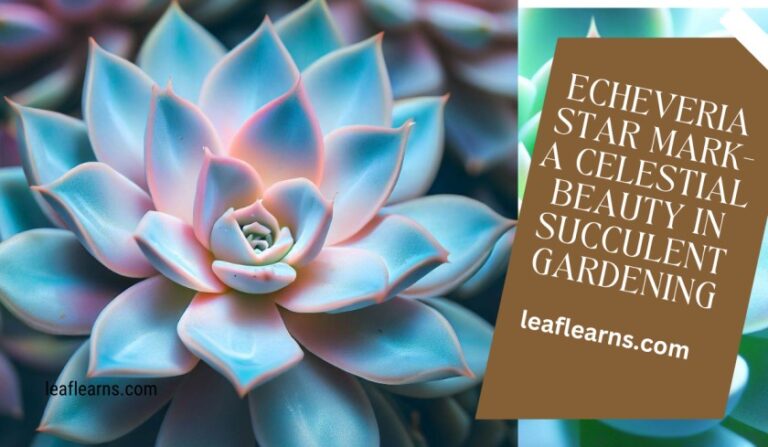How to Care and Guide the Snake Plant (2023)
Sansevieria trifasciata, the scientific name for the snake plant, is a member of the asparagus family and is native to West Africa’s tropical areas, which range from Nigeria to the Congo. Depending on the species and its location, this hardy evergreen perennial blooms in a variety of sizes, ranging from 6 inches to a towering 12 feet.
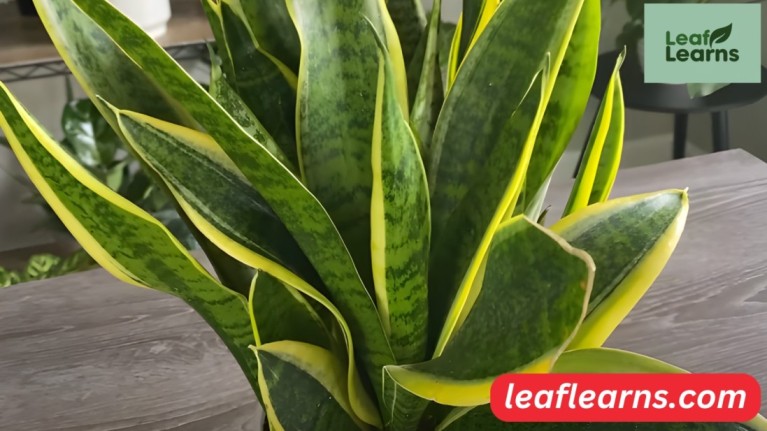
Contents
- 1 Leaves Variations
- 2 Prune and Soil
- 3 Top Care Tips
- 4 Care for Snake Plant
- 5 Light Requirement
- 6 Propagating Snake Plant
- 7 How to Grow Snake-Plant From Seed
- 8 Types/Varieties
- 9 Pruning
- 10 Growth Rate and Size
- 11 Repotting
- 12 Flowering and Foliage
- 13 Overwintering
- 14 Common Pests
- 15 Plant Diseases
- 16 How to Get Bloom
- 17 Problems and Solutions
- 18 Toxicity of Snake Plant
- 19 Pets
- 20 Snake Plant Appearance
- 21 Suggested Uses
- 22 Plant Care: A Guide to Thriving Indoors and Outdoors
- 23 Plant Benefits: Air Purification, Feng Shui, and Health Gains
- 24 Conclusion
- 25 FAQs
Leaves Variations
Its sickly yellow variations contrast with its incredibly vivid green leaves, which may reach lengths of 2.5 to 3 feet and widths of 2 to 2.8 inches. The Snake Plant does best in environments with humidity levels between 30% and 50% and temperatures between 60 and 75 degrees Fahrenheit (16 to 24 degrees C).
Prune and Soil
Simple pruning involves cutting off undesirable shoots at the base. It can handle some mild shade, however, it loves full of the sun. It grows best in sandy, well-drained soil, and it’s important to note that it is harmful to cats and dogs.
| Common name | Snake-Plant |
| Scientific Name | Sansevieria trifasciata |
| Family | Asparagus |
| Distribution | Tropical West Africa from Nigeria east to the Congo |
| Plant type | Evergreen perennial |
| Size | 6 inches to 12 feet tall in native habitat depending on variety |
| Leaf Colour | Vibrant green to a sickly yellow |
| Leaf size | 2.5 and 3 feet in length and 2 to 2.8 inches in width |
| Temperature | 60-75 degrees F. (16-24 degrees C) |
| Humidity | Between 30 and 50% |
| Pruning | Using a sharp, clean blade, simply cut off the stalks you’d like to remove at the base, closest as possibly to the soil. |
| Light requirement | Plentiful sunlight, but will put up with some light shade and continue to grow |
| Soil requirement | Sandy, well-drained |
| Toxicity | Toxic to Cats and Dogs |
| Propagation | Leaf cuttings, rhizome division, or by offsets (pups). Water and soil propagation |
| Flower colour | Greenish flowers |
| Pests | Mealybugs, spider mites and thrips |
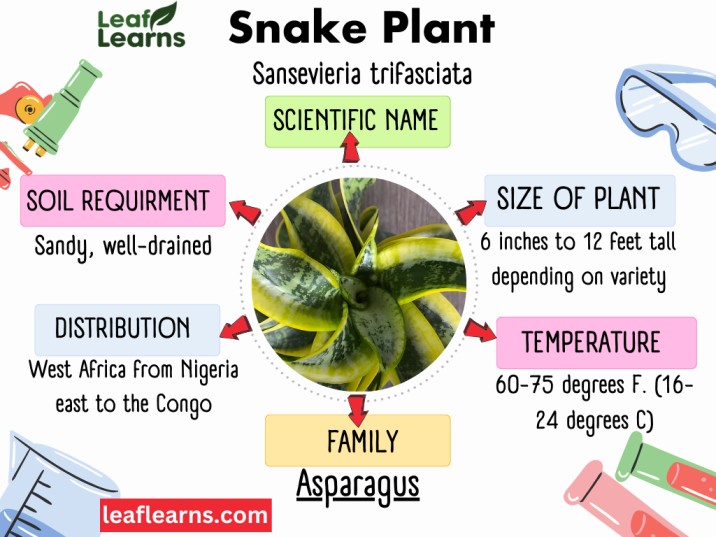
Top Care Tips
Light: Put your snake-plant in a dimly lit area or some indirect sunlight. Although it loves indirect light, it can withstand some direct sunshine.
When watering, let the soil dry out in between applications. Since they can withstand drought, this plant are more susceptible to overwatering than underwatering.
Use a well-draining potting mix for the soil. It’s best to use a combination of succulents or cacti. Avoid soils that are thick or flooded.
Keep your snake-plant between 70 and 90 degrees Fahrenheit (21-32 degrees Celsius). Although it can withstand brief temperature decreases, sustained exposure to cold can be harmful to plants.
At the plant’s base, remove any leaves that are dead or yellow. During the spring and summer growing season, fertilise only occasionally, perhaps once a month.
Care for Snake Plant

Light Requirement
Light: Place your snake-plant in low light or indirect sunlight.In particular when it comes to light, this plant are simple to care for. They make little demands.
Simply position them in areas with indirect sunlight or even in dimly lit areas. Consider the locations where you can read a book throughout the day without using a lamp; that should be adequate light for your snake-plant.
Avoid the sun’s rays; they might burn the foliage. Keep in mind that these plants are the low-light champions of the plant kingdom!
Water Requirements
When it comes to water, this plants are sort of the “lazy” pals of the plant world. They don’t require a lot! Consider giving them a sip rather than a shower.
Every two to four weeks, or when the soil feels dry an inch deep, lightly water your snake-plant. Allow them to enjoy a little period of drought in between sips as overwatering might be their enemy. It’s the secret to their fulfillment!
Soil Requirement
Soil has a huge role in snake-plant care! A sandy or succulent combination of soil that drains properly is what you need. This helps stop the roots from decaying when they are submerged in water.
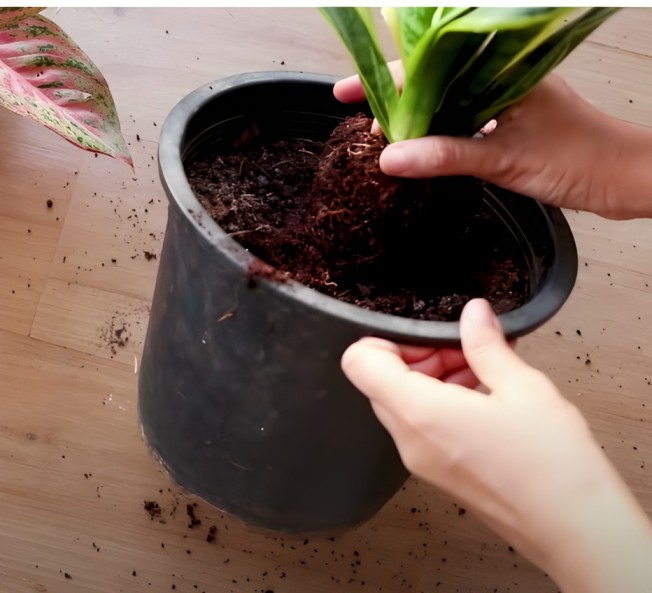
Use of dense or soggy soil is prohibited. In order to avoid having tooggy dirt, make sure your plant’s soil dries dry between watering.
Temperature Requirement
When it comes to temperature, consider your snake-plant to be a Goldilocks plant while caring for it. neither too chilly nor too hot.
Maintain a comfortable environment for your this kind of plant that is neither too cold (above 50°F or 10°C) nor too hot (below 85°F or 30°C). Perfect for growth!
Humidity Requirement
This plants require little humidity and are simple to maintain. They resemble hardy, self-sufficient plants that can withstand the dry air in your house.
They’ll be content if you just water them gently and let the soil dry in between applications. They are low-maintenance, so there is no need for a humidifier!

Fertilizer Requirement
Simply give it a liquid fertilizer that has been balanced and diluted every two to three months during the growing season (spring and summer).
To make the fertilizer weak, like a half-strength juice, combine it with water. Don’t overdo it, but do carefully pour it on the soil. Too much might hurt your plant.
Potting Requirement
The secret to successfully potting your snake-plant is to select a well-draining container and soil. Make sure the pot has drainage holes since this plants don’t want their feet to be damp.
Use a potting mix made for succulents or cacti to avoid overwatering.

Propagating Snake Plant
Leaf Cuttings
Each part of a healthy leaf should be around 2-3 inches long. To avoid rot, give them a day or two to dry out and develop calluses. After that, bury the cuttings in a well-draining soil mixture about 1 inch deep.
until they begin to root, use little water.
Division
You can divide your snake-plant if it has gotten too big. To gently separate the offsets (baby plants) from the main rhizome, remove the plant from its container.
The offsets should be repotted in new soil in their own containers.
Rhizome Cuttings
Make sure each portion of a healthy rhizome (horizontal stem) contains a few inches of stem and roots.
Make sure the chopped ends of these portions are hidden by planting them in the ground. Water sparingly until the roots take root.
Water Propagation
Cut ends of Snake-Plant cuttings or leaves should be submerged in a water-filled container. To avoid rot, change the water every few days.
After a few weeks, roots will start to appear. Move the cuttings to the soil once they have established themselves.
Offsets
Plants naturally develop “pups” or offsets at the mother plant’s base.
These may be properly separated and each planted separately, which takes less work than other methods of propagation.
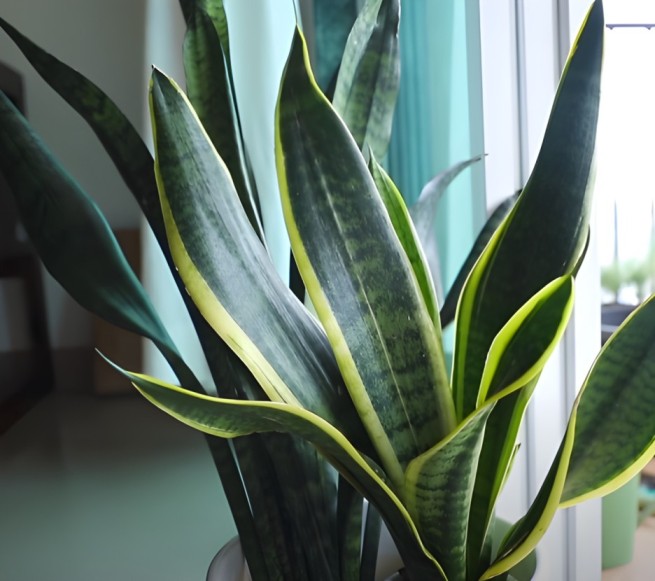
How to Grow Snake-Plant From Seed
Growing this plants from seeds is uncommon since they typically grow via divisions or cuttings. Get Plant seeds, or gather them from established plants, if you wish to attempt it.
Plant them in wet, well-draining soil with indirect lighting. The growth of seedlings will take time. For quicker results, cuts or divisions are simpler to propagate.
Types/Varieties
Sansevieria trifasciata: This is the most prevalent kind, with erect, sword-shaped leaves that are striped in green and grey. It is frequently referred to as the “Mother-in-Law’s Tongue.”
Sansevieria trifasciata ‘Laurentii’: While resembling the typical Snake-Plant, it has ornamental yellow borders on its leaves.
Sansevieria cylindrica: This type stands out visually thanks to its cylindrical, spear-shaped foliage as opposed to the usual flat leaves.
Sansevieria hahnii: It also goes by the name “Bird’s Nest Snake-Plant,” and it has shorter, broader leaves that create a rosette.
Sansevieria masoniana: The broad, paddle-shaped leaves of this snake-plant are what give it its common names of “Whale Fin” and “Shark Fin.”
Sansevieria trifasciata ‘Moonshine’: This type features silvery-gray leaves, giving it an elegant and modern appearance.
Sansevieria trifasciata ‘Bantel’s Sensation’: Recognized by its narrow, white-striped leaves, creating a striking contrast.
Sansevieria trifasciata ‘Futura Superba’: characterized by its modest silver-gray-green leaves and compact growth.
Pruning
When pruning this plant, you remove any dead or yellowing leaves. This aids the plant’s concentration in developing fresh, healthy leaves.
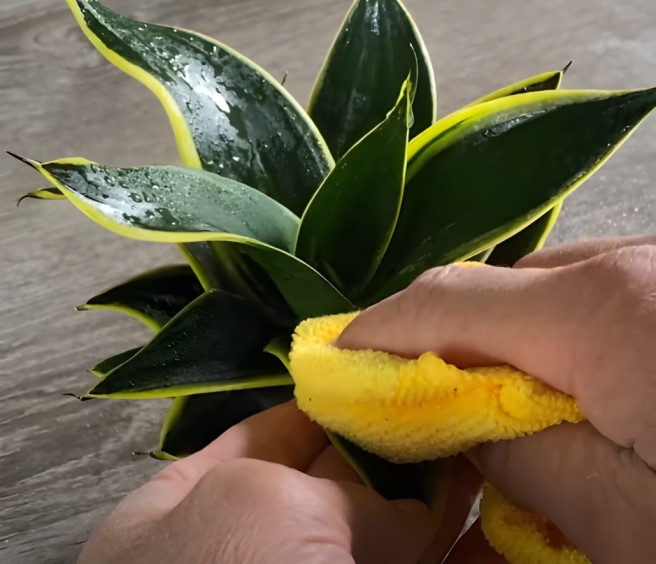
Snip the dead sections at the root using clean shears or scissors. It’s similar to giving your plant a haircut to maintain it healthy and looking its best.
Growth Rate and Size
This plant doesn’t get very big and grows slowly. It resembles a kind buddy. It could take some time, but it won’t take up too much room.
It usually stands between two and four feet tall. Since it’s a cool plant, there’s no need to be concerned about it growing too big too quickly.
Repotting
- Select a Larger Pot: Select a pot with a diameter that is 1-2 inches greater than the existing one.
- Use a succulent-friendly, well-draining soil mixture while preparing the soil.
- Remove Carefully: Remove the plant from the old pot gently.
- Put in New Pot: Place it in the pot and add soil.
- Water sparingly, then wait for it to settle.
Flowering and Foliage
The Mother-in-Law’s Tongue or snake-plant is well-known for its lovely leaves. Its lengthy, sword-like leaves, which have a variety of colours and patterns, bring beauty to your environment.
Although this plants are mostly grown for their leaves, they can also produce tiny white or greenish flowers. They are not particularly spectacular and may not always bloom.
Overwintering
Caregiving throughout the cooler months is necessary for this plants to overwinter. Since snake-plants love warm climates, it’s essential to keep them out of frigid weather.
If your area gets cold, bring your snake-plant indoors. Avoid overwatering and put it in an area with indirect sunshine. Water lightly and let the soil dry between applications over the winter.
Common Pests
Tiny pests like mealybugs and spider mites are frequent pests that might trouble your snake-plant. They drain the plant’s fluids like plant vampires.
Webbing or cottony material on your plant is a clue that something is wrong. Using insecticidal soap or cleaning the leaves of your plant with soap will help you get rid of them.
Maintaining a clean and healthy plant can help keep these tiny troublemakers out.
Plant Diseases
Like any other plant, snake-plants are susceptible to plant diseases, which can be problematic if not treated. Root rot brought on by excessive watering or ill-draining soil is a typical issue. Too much direct sunlight can cause brown patches and curled foliage.
Yellow leaves might be a sign of overwatering or insufficient lighting. Maintain appropriate irrigation, offer indirect lighting, and make sure the soil drains effectively to avoid these illnesses.
How to Get Bloom
This plants are renowned for producing stunning, although seldom, flowers. Make sure your plant receives indirect sunshine and a steady temperature of about 70-90°F (21-32°C) to promote flowering.
Use a small container to keep the plant minimally root-bound. Use little water, letting the soil dry out between applications.
Because this type of plants seldom blossom and it can take years, patience is essential. Enjoy the fragrant, star-shaped blooms that emerge on tall spikes when it eventually do!
Problems and Solutions
Problem: Yellowing leaves
Solution: Reduce soil moisture and make sure it dries out between waterings.
Problem: Drooping leaves
Solution: Give your snake-plant additional light, but keep it out of the sun’s direct rays.
Problem: Brown tips
Solution: Use well-draining soil, keep humidity levels at the right range, and refrain from overfertilizing
Problem: Slow growth
Solution: If the plant’s roots are confined, repot it and make sure it receives appropriate care and periodic feedi
Problem: Pest infestation
Solution: Isolate the plant, get rid of any obvious pests, and use neem oil or insecticidal soap to cure.
Toxicity of Snake Plant
Although snake-plants are normally benign, it’s important to be aware that if pets eat them, they might become hazardous.
The plant contains substances that can make dogs and cats drool, throw up, or have upset stomachs. It is therefore essential to keep them away from curious dogs.
While not fatal to humans, it is not a good idea to consume snake-plant because it might induce some gastrointestinal pain. It is preferable to admire them from a secure distance and avoid any unintentional nibbling.
Pets
Popular indoor plants with a reputation for cleansing the air. It’s important to keep in mind, though, that cats and dogs who are naturally interested might become poisonous after ingesting this plants.
To protect them from pets, keep them out of their reach. Even while snake-plants have many advantages, they are hazardous to pets, thus it is advisable to use non-toxic plants if you have any at home. Security first!
Snake Plant Appearance
Sansevieria, have a distinctive look. They have robust, sword-shaped, long, upright leaves that are usually green with greyish-green stripes.
Though some kinds have distinctive patterns, all have a streamlined, contemporary appearance. These plants are excellent for house decor because they can go up to a few feet tall.
Both novice and expert plant enthusiasts choose them because of their remarkable look and air-purifying properties.
Suggested Uses
- Air purifier: Snake-plants are very effective in removing pollutants from indoor air, including formaldehyde and benzene.
- They make fashionable, low-maintenance houseplants that bring a dash of green to your living areas.
- Snake-plants are excellent bedside plants because they produce oxygen at night, which helps the air quality in the room.
- Feng Shui: When put in particular regions of your home, it is said to bring luck and good energy.
- Office greenery is perfect for settings in offices since it requires little maintenance and may grow in low light.
- For friends and family, they make meaningful and long-lasting presents.
- Traditional medicine: Used for a variety of medical conditions in some cultures.
- Folklore: Known as superstitions and folklore in various locales.
- Some people utilize snake-plants in rituals or spiritual practices.
- Plants that go well together include peace lilies, spider plants, and aloe vera.
- Study their distinctive leaf patterns and growth patterns if you’re interested in botany.
- These applications highlight how adaptable snake-plants are to several facets of life.
Plant Care: A Guide to Thriving Indoors and Outdoors
Sansevieria, is a versatile and resilient plant that comes in various types and varieties. Its adaptability makes it suitable for both indoor and outdoor settings, adding a touch of greenery to your space.
When it comes to snake-plant care, it’s relatively low-maintenance, making it an excellent choice for beginners and busy individuals.
It thrives in various light conditions, from low to bright indirect sunlight, and is forgiving when it comes to watering. However, overwatering can lead to issues like brown tips and root rot, so it’s essential to let the soil dry out between waterings.
Plant Benefits: Air Purification, Feng Shui, and Health Gains
One of the standout features of the snake-plant is its air-purifying abilities, which make it an ideal choice for enhancing indoor air quality. It removes toxins from the air, making it beneficial not only for your health but also for creating a serene and pollution-free environment in your bedroom, office, or living space.
In the world of feng shui, snake-plants are believed to bring positive energy and luck when placed strategically. Moreover, snake-plants are widely available and reasonably priced, making them accessible to plant enthusiasts.
Whether you’re looking to buy snake-plants online or at local nurseries, they’re readily available for purchase. However, it’s crucial to be aware that while snake-plants are pet-safe, they can be toxic to cats and dogs if ingested, so it’s best to keep them out of reach of your furry friends.
Conclusion
In conclusion, maintaining a snake-plant is simple. The main recommendations are to provide it with the proper lighting, water it sparingly, use well-draining soil, maintain a comfortable temperature, and sometimes prune.
This plants are attractive, beneficial for the environment, and work well in businesses or homes. They are fashionable and adaptable. Just keep in mind that they do not allow pets.
FAQs
Where should you place your Snake Plant to ensure proper lighting?
Place it in indirect sunlight or low-light conditions.
How often should you water your Snake Plant to keep it happy?
Water it moderately, about every 2-4 weeks, or when the soil is dry an inch deep.
What type of soil is best for Snake Plant care?
Well-draining soil like a sandy or succulent mix works well.
What is the recommended temperature range for a Snake Plant?
Keep it in a range of 70-90°F (21-32°C) for optimal growth.
How often should you prune your Snake Plant, and when should you fertilize it?
Prune as needed, and fertilize sparingly, about once a month during the growing season (spring and summer).
Can Snake Plants tolerate direct sunlight?
They can tolerate some direct sunlight but prefer indirect light.
What is a key consideration when repotting a Snake Plant?
Choose a pot with drainage holes and use a well-draining soil mix suitable for succulents.

